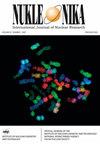Radon variability due to floor level in two typical residential buildings in Serbia
IF 0.3
4区 物理与天体物理
Q4 CHEMISTRY, INORGANIC & NUCLEAR
引用次数: 6
Abstract
Abstract It is well known that one of the factors that influence the indoor radon variability is the floor level of the buildings. Considering the fact that the main source of indoor radon is radon in soil gas, it is expected that the radon concentration decreases at higher floors. Thus at higher floors the dominant source of radon is originating from building materials, and in some cases there may be deviations from the generally established regularity. In such sense, we chose one freestanding single-family house with loft and other 16-floor high-rise residential building for this study. The indoor radon measurements were performed by two methods: passive and active. We used passive devices based on track-etched detectors: Radtrak2 Radonova. For the short-term indoor radon measurements, we used two active devices: SN1029 and SN1030 (manufactured by Sun Nuclear Corporation). The first device was fixed in the living room at the ground level and the second was moved through the floors of the residential building. Every measuring cycle at the specified floor lasted seven days with the sampling time of 2 h. The results show two different indoor radon behaviours regarding radon variability due to floor level. In the single-family house with loft we registered intense difference between radon concentration in the ground level and loft, while in the high-rise residential building the radon level was almost the same at all floors, and hence we may conclude that radon originated mainly from building materials.塞尔维亚两栋典型住宅的氡变化与楼层水平有关
众所周知,影响室内氡变化的因素之一是建筑物的楼层水平。考虑到室内氡的主要来源是土壤气体中的氡,预计较高楼层的氡浓度会降低。因此,在较高的楼层,氡的主要来源是建筑材料,在某些情况下,可能会偏离通常确定的规律。在这种意义上,我们选择了一栋带阁楼的独立式独栋住宅和另一栋16层的高层住宅进行研究。室内氡测量采用两种方法:被动和主动。我们使用了基于轨道蚀刻探测器的无源器件:Radtrak2 Radonova。对于短期室内氡测量,我们使用了两种有源设备:SN1029和SN1030(由太阳核公司制造)。第一个装置固定在一楼的客厅里,第二个装置在住宅楼的地板上移动。指定楼层的每个测量周期持续7天,采样时间为2小时。结果显示,由于楼层水平的不同,室内氡有两种不同的变化行为。在有阁楼的独栋住宅中,我们发现地面和阁楼的氡浓度存在很大差异,而在高层住宅中,所有楼层的氡水平几乎相同,因此我们可以得出结论,氡主要来源于建筑材料。
本文章由计算机程序翻译,如有差异,请以英文原文为准。
求助全文
约1分钟内获得全文
求助全文
来源期刊

Nukleonika
物理-无机化学与核化学
CiteScore
2.00
自引率
0.00%
发文量
5
审稿时长
4-8 weeks
期刊介绍:
"Nukleonika" is an international peer-reviewed, scientific journal publishing original top quality papers on fundamental, experimental, applied and theoretical aspects of nuclear sciences.
The fields of research include:
radiochemistry, radiation measurements, application of radionuclides in various branches of science and technology, chemistry of f-block elements, radiation chemistry, radiation physics, activation analysis, nuclear medicine, radiobiology, radiation safety, nuclear industrial electronics, environmental protection, radioactive wastes, nuclear technologies in material and process engineering, radioisotope diagnostic methods of engineering objects, nuclear physics, nuclear reactors and nuclear power, reactor physics, nuclear safety, fuel cycle, reactor calculations, nuclear chemical engineering, nuclear fusion, plasma physics etc.
 求助内容:
求助内容: 应助结果提醒方式:
应助结果提醒方式:


